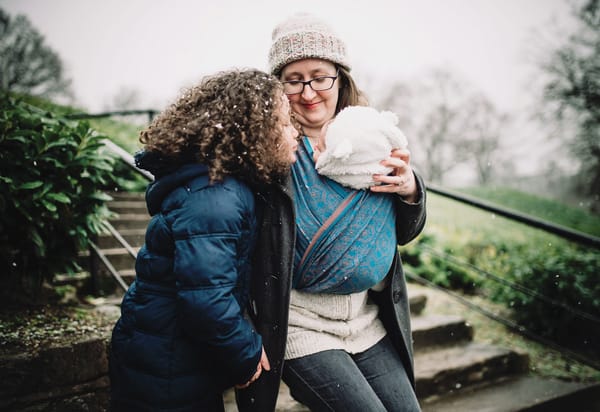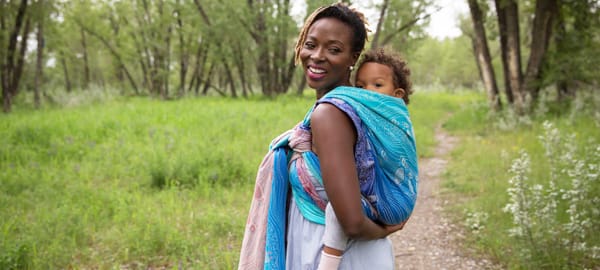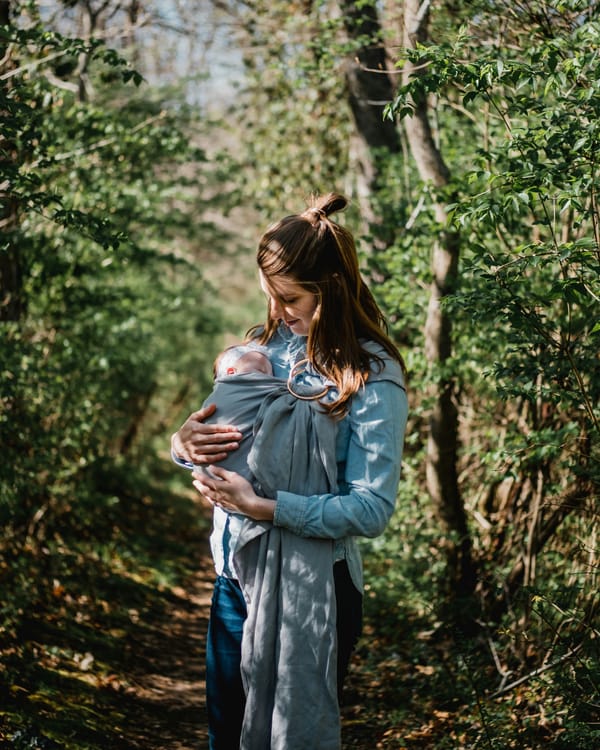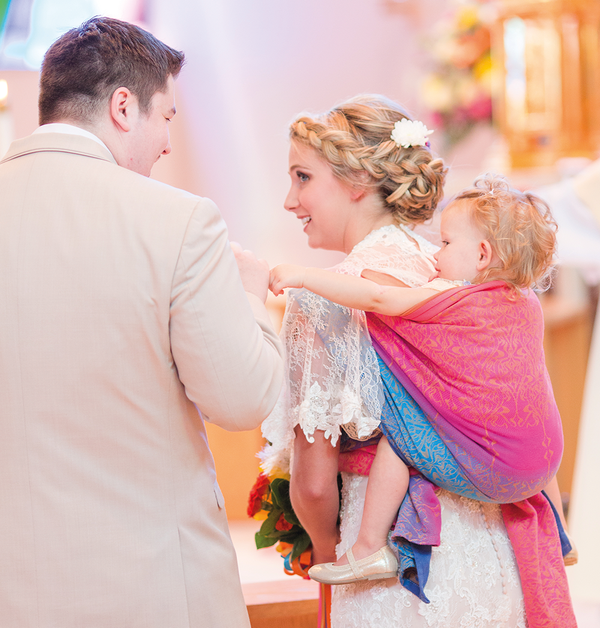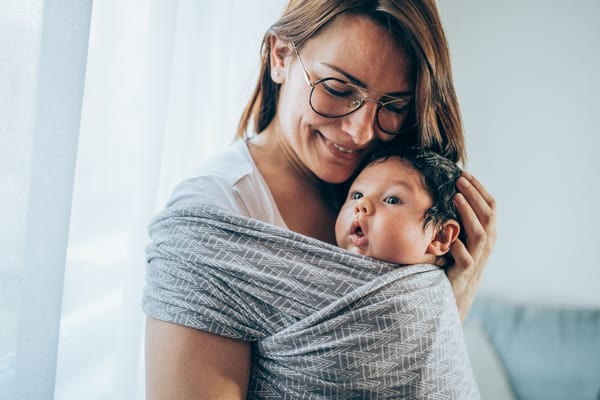Hannah Thomas talks about why she still wears her 4 year old
My four-year-old daughter, Maggie, had a very difficult start in life. The healthy physiological home birth we had carefully prepared for didn't go as we hoped, and I couldn't hold her until she was three days old. And I wasn’t able to breastfeed her for five days, after she aspirated meconium just before her forceps assisted delivery.
After the trauma of our separation in NICU, once we brought her home on her 11th day, I followed my instincts to always keep her close to give her body and her spirit the safety and co-regulation that she needed to recover, and the connection we both needed to heal. Babywearing in a sling was the perfect way to be close at all times.
We are a carrying species
Learning about the benefits of attachment parenting and having an understanding that our infants expect - on a primal level - to be held (all the time!) strengthened our desire to responsively breastfeed, bedshare and babywear. I knew that was the best thing I could do to help us heal - as well as making mothering so much easier!
As Dr Rosie Knowles, author of Why Baby Wearing Matters explains "Carrying your baby is essential to their normal physical, psychological and neurological development. Human bodies are adapted to be a carrying species, it is part of our evolutionary history."
So many of the benefits Maggie received from being carried when she was newborn still apply now she is four.
Here are some of the benefits:
• Helps me to feel close to her physically now that she doesn't breastfeed, or want me to cuddle her very often
• Supports her need for security and attachment to me
• Helps to regulate her body, particularly when she's unwell
• Helps her to feel calm and relaxed when she's feeling agitated and disconnected
• Allows her a space to retreat from an often-overwhelming world
• Allows her to engage with situations where she feels nervous from a position of safety
• Makes it possible to be close to her whilst keeping my hands free for other jobs, and helping my other child
• Keeps her out of harm's way if necessary: for example, on a walk near a busy road or deep water, I can relax and just enjoy being close with her.
Pregnancy interrupted our connection
Maggie was two-years-old when I became pregnant with our second daughter. I continued baby wearing her on my back, knowing that it would help maintain our connection and ease her anxieties about the big changes coming. This was especially important as pain and aversion during pregnancy limited how we were able to connect through breastfeeding. I grieve the loss of the enjoyable, easy breastfeeding connection we had before that time.
After Rosalie was born, I felt Maggie's sadness that I couldn't carry her anymore and could see in her eyes that she felt she'd been replaced. Although my husband was careful to give her chances to still be 'the baby' in the carrier, I knew it wasn't the same.
So as soon as I was out of the fourth trimester, I started wearing her in the carrier again. I managed to persevere with tandem nursing until Maggie was three. Once our breastfeeding journey came to an end (earlier than I had hoped), I knew having physical closeness, and connection, in the carrier, was even more important for both of us.
A chance to 'be the baby' again
Maggie has taken Rosalie's arrival hard - and I keenly empathise with the insecurity and instability she feels in our family, and the outside world, after such a big change.
Our relationship has changed since her sister arrived, and she now resists being close to me or comforted by me, because (in her own words) "when you hug me it makes me feel more," but one thing she never refuses is a 'cuddle carry.'
When I can see and sense her physical overwhelm, agitation in her spirit, disregulation in her nervous system, and emotional disconnection between us - when she is being provocative, lashing out at her sister, trying to suppress her feelings - I know she will benefit from coming up in the carrier.
When she is on my back, I feel her body and her energy settle in a way she rarely does otherwise.
Sometimes I'll just put her in for ten minutes while I do the washing up, or longer while we walk to the shops. Whenever I do, I can immediately feel the relief it brings her - she softens, relaxes and nestles into me.
I can tell it gives her some space to emotionally reset, gives her animal body the womb-like squeeze, close contact and rhythmic movement to feel deepdown safe. It also allows my energy body to help co-regulate her energy (I think of it like giving her an energetic refresh - soothing away what she doesn't need, and boosting what she needs more of ).
We recently bought a preschool carrier that is suitable until around age 7, and I am proud to say I will keep wearing her for as long as I can. It is a gift to our children that benefits them body, mind and soul. In our family, babywearing definitely isn't just for babies.
Childwearing Carriers
Zoë Woodman from The Sling Consultancy talks to us about babywearing an older child.
"Most standard carriers will fit well until around two years, depending on the model. A ‘toddler’ or ‘preschool’ carrier is designed specifically to fit older children, offering support that is generally higher and wider than standardsized carriers, which is more comfortable when you are carrying 15+kg.
Not all carriers are created equal - different ones may be labelled toddler but can vary in width and height between brands, and the amount of padding to the shoulders and waistband.
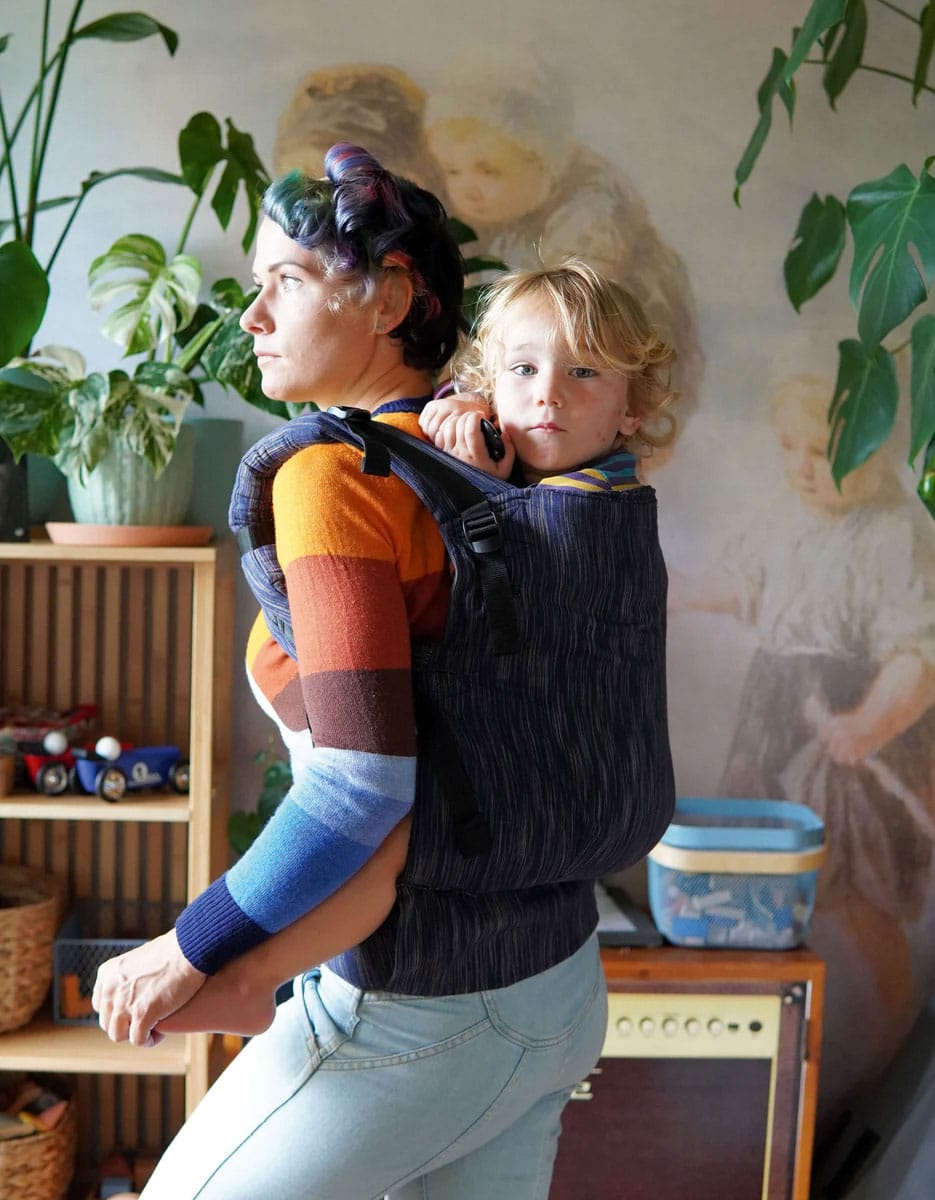
Carriers for older children range from less structured designs such as:
Integra (Size 3 fits around 3 - 5 years) integrababy.co.uk
KahuBaby (Toddler fits 18 months - 4 years) kahubaby.com
Izmi (Toddler fits 9 months - 3 years) izmibaby.co.uk
to more structured carriers such as:
Lenny Lamb Toddler (fits 12 months - 3 years) and Preschool carrier (fits 18 months - 7 years up to 30kg) en.lennylamb.com
Tula Toddler (fits 2 years+) and Preschool (from 3 years up to 32kg) babytula.co.uk
Easy Feel Extend Plus (pictured above, suitable up to 29kg) easyfeelproducts.com
YOUR CHILD CARRYING CHECKLIST
When carrying a heavier child, it is important to ensure a good fit:
• well-tightened
• waistband level not tilting down when the child is in
• shoulder straps fitting well and not too loose
• fabric going from child’s knee to knee
Seek support from a trained consultant or sling library if you’re finding carrying isn’t comfortable as often small tweaks make a huge difference. Find your local sling library at carryingmatters.co.uk
Q&A with Maggie
What do you like about being in the carrier?
"It feels nice like a piggyback but better 'cos I don't have to hold on. I like walking in the carrier so if I'm tired, I can just fall asleep. The carrier squeezes me, and I feel cosy. In the daytime I feel safest in the carrier and at nighttime I feel safest under the covers next to mummy."
What was it like when mummy couldn't have you in the carrier when Rosalie was born?
"It felt like I had to ask daddy to pick me up all the time 'cos I know you couldn't do it. I kept thinking "when is mummy going to be able to carry me again?"
What would you say if someone thought carriers were just for tiny babies?
"I'd say, actually they're not. You can just get a bigger carrier! I hope mummy and daddy will keep wearing me in the carrier until I'm a grown up, as long as we can."



